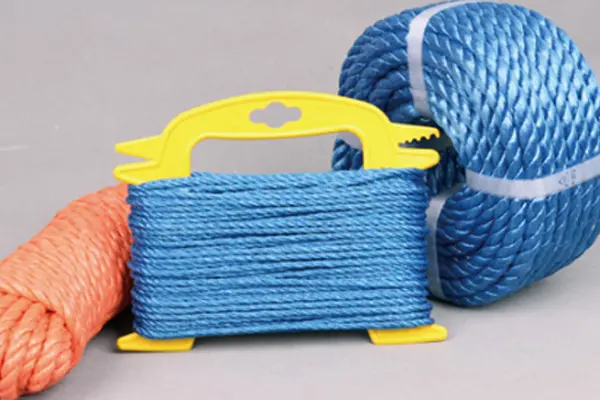Copyright © 2012-2025 Trust-k Cordage Manufacture Industrial Co., Ltd. Powered by iglobalwin.com
The specific use of rope
Ropes are mainly used in the fields of ship equipment, fishery fishing, port loading and unloading, electric power construction, petroleum exploration, national defense and military industry, and sports goods. Its structure is divided into three strands, eight strands, and twelve strands. The products are widely used and have the characteristics of high strength, low elongation, wear resistance, soft and smooth, and convenient operation.
Precautions for the use of the rope: Before each use of the rope, carefully check the marking and label insertion loops, whether the rope body has cuts, broken strands, broken wires, kinks and other damaged parts, if there are no abnormalities or defects It can be used normally; when unrolling the rope, the rope should be released from the rope end in the loop, and the rope should be released counterclockwise.

If the rope is unrolled counterclockwise, kinking of the rope will occur. If there is a kink, put the rope back into the loop, flip the loop, and then pull the rope from the center. A better way is to unwind the rope on a turntable, and then pull the rope from the outer rope end. If a person stands under an over-tensioned rope, there will be danger. Once the rope is out of control, a huge pull back will occur, which may cause casualties. If the rope is unrolled from the rope shaft, the rope shaft itself should rotate freely. It is easy to do this by using a tube through the center of the rope shaft. However, it is forbidden to extend the rope by placing the rope shaft vertically; if the rope is unrolled from the pulley device, the pulley The ratio of the diameter D of the rope to the diameter d of the rope should exceed 5, but the ratio can reach 20 for some high-performance fiber ropes.
For ropes, it is recommended that the diameter of the pulley groove is 10%-15% larger than the diameter of the rope. If the arc of the rope contacting the groove is 150 degrees, the rope can reach the best state of force, and the height of the pulley flange should be at least 1.5 times the rope diameter. To prevent the rope from running out of the pulley. In addition, the pulleys should be checked frequently and the bearings should be maintained regularly to ensure smooth rotation of the pulleys.
The rope should be scrapped or discontinued in the following situations: the rope has obvious scorching or melting; the straight line distance is equal to the length of the rope, and the volume of the surface rope or strand is reduced by 10%; the rope leaks in the extreme temperature beyond the range Environment; UV exposure degrades and the surface of the rope yarn becomes fragmented; the rope appears in the severely damaged hot melt, hardened, and flattened area; the number of rope yarns affected by melting or fusion exceeds 20%.
Ropes are mainly used in the fields of ship equipment, fishery fishing, port loading and unloading, electric power construction, petroleum exploration, national defense and military industry, and sports goods. Its structure is divided into three strands, eight strands, and twelve strands. The products are widely used and have the characteristics of high strength, low elongation, wear resistance, soft and smooth, and convenient operation.
Precautions for the use of the rope: Before each use of the rope, carefully check the marking and label insertion loops, whether the rope body has cuts, broken strands, broken wires, kinks and other damaged parts, if there are no abnormalities or defects It can be used normally; when unrolling the rope, the rope should be released from the rope end in the loop, and the rope should be released counterclockwise.

If the rope is unrolled counterclockwise, kinking of the rope will occur. If there is a kink, put the rope back into the loop, flip the loop, and then pull the rope from the center. A better way is to unwind the rope on a turntable, and then pull the rope from the outer rope end. If a person stands under an over-tensioned rope, there will be danger. Once the rope is out of control, a huge pull back will occur, which may cause casualties. If the rope is unrolled from the rope shaft, the rope shaft itself should rotate freely. It is easy to do this by using a tube through the center of the rope shaft. However, it is forbidden to extend the rope by placing the rope shaft vertically; if the rope is unrolled from the pulley device, the pulley The ratio of the diameter D of the rope to the diameter d of the rope should exceed 5, but the ratio can reach 20 for some high-performance fiber ropes.
For ropes, it is recommended that the diameter of the pulley groove is 10%-15% larger than the diameter of the rope. If the arc of the rope contacting the groove is 150 degrees, the rope can reach the best state of force, and the height of the pulley flange should be at least 1.5 times the rope diameter. To prevent the rope from running out of the pulley. In addition, the pulleys should be checked frequently and the bearings should be maintained regularly to ensure smooth rotation of the pulleys.
The rope should be scrapped or discontinued in the following situations: the rope has obvious scorching or melting; the straight line distance is equal to the length of the rope, and the volume of the surface rope or strand is reduced by 10%; the rope leaks in the extreme temperature beyond the range Environment; UV exposure degrades and the surface of the rope yarn becomes fragmented; the rope appears in the severely damaged hot melt, hardened, and flattened area; the number of rope yarns affected by melting or fusion exceeds 20%.
